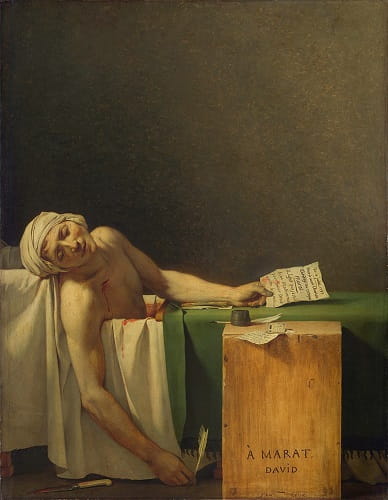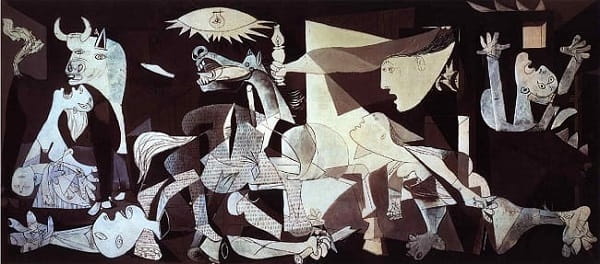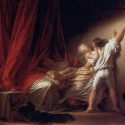The Third of May 1808 Analysis
Welcome to our comprehensive analysis of “The Third of May 1808,” an emotionally charged and historically significant masterpiece by renowned Spanish artist Francisco Goya. In this article, we will delve deep into the heart of this iconic artwork, uncovering the courageous narrative it portrays amidst the tragedy of war.
As we explore the artistic brilliance and symbolism behind Goya’s brushstrokes, you’ll gain a profound understanding of this powerful painting that continues to captivate art enthusiasts and history buffs alike.
Throughout this analysis, we will highlight Francisco Goya’s influential role in the Romantic art movement, emphasizing his unique artistic style that defied conventions and stirred emotions. By exploring the technical aspects of Goya’s composition, brushwork, and use of symbolism, you’ll gain insights into the mind of a trailblazing artist whose work transcends time.
The Third of May 1808: Decoding Goya’s Masterpiece of Courage and Tragedy
Historical Background of The Third of May 1808 Painting
“The Third of May 1808” by Francisco Goya is a painting deeply rooted in historical events that unfolded during the early 19th century, specifically during the Peninsular War. To fully grasp the significance and emotional weight of Goya’s masterpiece, it is crucial to explore the historical backdrop that shaped the creation of this iconic artwork.

The Third of May 1808 (1814) by Francisco Goya
The Peninsular War: Napoleon’s Ambition in Spain
The Peninsular War (1808-1814) was a major conflict that emerged from the ambitious expansion plans of Napoleon Bonaparte, Emperor of France. In 1808, Napoleon sought to consolidate his control over Europe, including the Iberian Peninsula, which comprised Spain and Portugal. His intent was to secure these territories and establish family members as puppet rulers to strengthen his empire.
The Abdication of King Charles IV and the Rise of Joseph Bonaparte
In 1808, facing internal conflicts and political unrest, King Charles IV of Spain abdicated the throne in favor of his son, Ferdinand VII. However, Napoleon saw an opportunity to further his ambitions and persuaded Charles IV to renounce his abdication. In a controversial move, Napoleon appointed his brother, Joseph Bonaparte, as the new King of Spain, disregarding the Spanish people’s will and undermining their sovereignty.
The Spanish Resistance and Uprising
The imposition of Joseph Bonaparte’s rule incited widespread discontent among the Spanish population. The Spanish people were deeply attached to their monarchy and fiercely opposed foreign intervention in their affairs. This led to a spontaneous uprising against the French occupation, as ordinary citizens, soldiers, and guerrilla fighters rallied to defend their country’s independence.
The Dos de Mayo Uprising
On May 2, 1808, an uprising erupted in Madrid as the Spanish people took to the streets to resist the French occupation. In what became known as the Dos de Mayo Uprising, Spanish civilians and soldiers engaged in fierce street battles against the well-organized French forces. The initial uprising was met with brutal repression by the French troops, resulting in the execution of numerous Spanish civilians and resistance fighters.
The Third of May 1808: A Pivotal Moment in History
“The Third of May 1808” captures the aftermath of the Dos de Mayo Uprising. In the painting, Goya depicts the moment when the French army executed Spanish civilians in retaliation for their resistance. The central figure, with arms outstretched in a Christ-like pose, represents the ultimate sacrifice of an innocent victim, while the surrounding figures symbolize the collective anguish and fear faced by the Spanish people.
Symbolism and Emotions in “The Third of May 1808” Painting
Francisco Goya’s “The Third of May 1808” is not only a powerful historical narrative but also a deeply symbolic artwork that evokes a range of emotions from the viewer. The painting’s composition and symbolism contribute to its emotional impact, conveying the human cost of war and the resilience of the human spirit.
1- The Central Figure: Sacrifice and Innocence
At the heart of the painting stands a central figure, an anonymous Spanish civilian with his arms outstretched in a Christ-like pose. This poignant representation of sacrifice and innocence becomes the focal point of the artwork. The figure’s white clothing adds to the sense of purity and vulnerability, emphasizing the tragedy of the impending execution.

An anonymous Spanish civilian with his arms outstretched in a Christ-like pose in The Third of May 1808 painting.
2- The Lantern: Illuminating the Truth
A lantern is placed on the ground near the central figure, casting a beam of light that illuminates the faces of those about to be executed. It casts a beam of light, revealing the faces of those about to be executed, humanizing them and evoking empathy from the viewer.

A lantern is on The Third of May 1808.
The light also metaphorically represents the truth and the revelation of the atrocities committed, bringing them into stark focus.
3- The Gestures and Expressions: Fear and Courage
Goya skillfully portrays a range of emotions through the gestures and expressions of the figures in the painting. The Spanish civilians facing the French firing squad exhibit fear, desperation, and resignation, while the French soldiers remain cold and impassive.

The gestures and expressions of the figures in the painting.
The stark contrast in emotions highlights the brutal reality of war and the courage of those facing their imminent death with dignity.
4- The Hands: Humanity and Vulnerability
Hands play a significant role in the painting, symbolizing humanity and vulnerability. The outstretched arms of the central figure evoke a crucifixion pose, emphasizing the sacrificial nature of the civilian’s impending fate. Additionally, the open hands of the figures facing the French rifles signify their powerlessness and submission.
5- The Faceless French Soldiers
The French soldiers depicted in uniform with their faces obscured symbolize the dehumanization of the oppressors.

The French soldiers are in The Third of May 1808 – The Third of May 1808 Analysis.
Francisco Goya intentionally does not individualize them, underscoring the facelessness of the invading forces and the brutality of war.
6- The Dark and Light Contrasts: Good and Evil
Goya’s masterful use of light and dark contrasts heightens the emotional impact of the painting.

Light and dark contrasts of The Third of May 1808.
The bright light focused on the central figure and the Spanish civilians contrasts sharply with the dark and shadowy background, symbolizing the struggle between good and evil and the stark divide between the victims and their oppressors.
“The Third of May 1808” is a masterful composition that transcends its historical context to convey universal themes of sacrifice, courage, and the horrors of war. Through intricate symbolism and emotive portrayals, Goya forces the viewer to confront the human toll of conflict and reflect on the enduring spirit of those who resist oppression.
This iconic artwork continues to resonate with audiences worldwide, reminding us of the power of art to evoke profound emotions and provoke contemplation about the human experience.
Comparisons of The Third of May 1808 with Other Artworks
“The Third of May 1808” by Francisco Goya is a masterpiece that stands out not only for its emotional intensity and historical significance but also for its unique artistic approach. When examining this iconic painting, it is insightful to explore comparisons with other artworks from various periods and artists who have also depicted war, conflict, and human suffering. By doing so, we can gain a broader understanding of how different artists have approached similar themes and how Goya’s work remains distinctive and impactful.
1- Jacques-Louis David’s “The Death of Marat” (1793)
One notable comparison can be made between Goya’s “The Third of May 1808” and Jacques-Louis David’s “The Death of Marat.” Both paintings are powerful depictions of tragic events during times of political upheaval. While Goya’s work captures the resistance of the Spanish people against the French occupation, David’s painting portrays the assassination of the revolutionary figure Jean-Paul Marat during the French Revolution.

The Death of Marat, 1793 by Jacques-Louis David – The Third of May 1808 Analysis.
Both artworks employ emotional intensity and symbolism to convey the sacrifices and heroism of individuals amid tumultuous historical contexts.
2- Pablo Picasso’s “Guernica” (1937)
Pablo Picasso‘s “Guernica” is another significant artwork that can be compared to Goya’s masterpiece. Created in response to the bombing of the town of Guernica during the Spanish Civil War, Picasso’s painting conveys the horrors of war and the devastation it inflicts on innocent civilians.

Guernica, 1937 by Pablo Picasso – Comparisons of The Third of May 1808 with Other Artworks.
Recommended For You – 8 Things You Need To Know About Picasso‘s Guernica
Both “Guernica” and “The Third of May 1808” share themes of violence, suffering, and the impact of war on civilians, but they differ stylistically. While Goya’s work is rooted in realism, Picasso’s masterpiece is characterized by Cubist elements and distorted forms.
3- Théodore Géricault’s “The Raft of the Medusa” (1819)
In “The Raft of the Medusa,” Théodore Géricault tackled another tragic event, depicting the aftermath of the shipwreck of the French frigate Medusa. This monumental painting portrays the harrowing experiences of the survivors stranded on a makeshift raft at sea. Like Goya’s artwork, “The Raft of the Medusa” confronts viewers with the horrors of human suffering and the indomitable will to survive in the face of adversity.

The Raft of the Medusa, 1819 by Theodore Gericault.
Recommended For You – The Raft of the Medusa Analysis: A Masterpiece of Romanticism and Tragedy
4- Käthe Kollwitz’s “The Grieving Parents” (1932)
Kathe Kollwitz’s “The Grieving Parents” is a poignant sculpture that portrays the profound grief of parents mourning the loss of their son during World War I. This sculpture shares a thematic connection with Goya’s work, as both depict the emotional impact of war on families and communities. Kollwitz’s sculpture emphasizes the universal theme of the sorrow and loss experienced by those left behind in times of conflict.
Recommended For You – Artifacts Missing in the Wake of World War II

The Grieving Parents, 1932 by Käthe Kollwitz – The Third of May 1808 Analysis.
Comparing “The Third of May 1808” with other artworks depicting war, conflict, and human suffering allows us to appreciate the diverse ways artists have tackled similar themes throughout history. While each artwork may differ in style and technique, they all communicate profound human experiences and emotions in the face of adversity. Goya’s masterpiece stands out for its raw emotional power, skillful use of symbolism, and ability to evoke empathy and contemplation in viewers, making it an enduring and impactful work of art.
Connecting History with Art
“Connecting History with Art” involves exploring the intersection between significant historical events and the artistic expressions that emerge in response to those events. Francisco Goya’s “The Third of May 1808” serves as a powerful example of how art can bear witness to history, capturing the emotions, struggles, and resilience of people during times of conflict.
Art as a Historical Document
“The Third of May 1808” serves as a historical document that immortalizes a pivotal moment in Spain’s struggle for independence during the Peninsular War.
Goya, himself a witness to the atrocities of war, transformed his canvas into a testimony of the brutal events that unfolded on May 3, 1808, in Madrid. By studying the painting, historians can gain insights into the emotions, actions, and reactions of both the Spanish civilians and the French soldiers during this tragic episode.
Art as a Reflection of Society
Goya’s artwork reflects the social and political context of its time. “The Third of May 1808” captures the fervor of nationalism and the collective spirit of resistance among the Spanish people.
It portrays the stark contrast between the occupied and the occupier, highlighting the clash of ideologies and the consequences of foreign intervention in the affairs of a nation. Through the portrayal of individuals facing their execution, Goya humanizes the victims of war and draws attention to the human cost of political conflicts.
Art as Protest and Advocacy
Art has often served as a medium for protest and advocacy, and Goya’s painting is a prime example of this. By depicting the atrocities committed by the French forces, “The Third of May 1808” condemns violence, oppression, and the abuse of power.
The painting is an impassioned plea for justice, a call to remember the victims, and a reminder of the importance of defending human rights and freedoms.
Art as a Catalyst for Change
“The Third of May 1808” is a testament to the enduring power of art to spark dialogue, challenge established norms, and inspire action. By presenting a stark reminder of the consequences of war and the importance of empathy and compassion, Francisco Goya’s masterpiece can provoke contemplation and discussions about the relevance of history in contemporary society.
Art, in this way, becomes a force that can shape public perception and influence change.
Connecting history with art allows us to gain a more profound understanding of historical events and the human experience. Francisco Goya’s “The Third of May 1808” exemplifies the potency of art as a historical document, a reflection of society, a medium for protest and advocacy, an expression of emotion, and a catalyst for change. By engaging with artworks like this, we can connect with history on a more personal and emotional level, ensuring that the lessons and stories of the past continue to resonate and inform our present and future.
References:
- https://en.wikipedia.org/wiki/The_Third_of_May_1808
- https://en.wikipedia.org/wiki/The_Death_of_Marat
- https://artinflanders.be/en/artwork/grieving-parents-2








